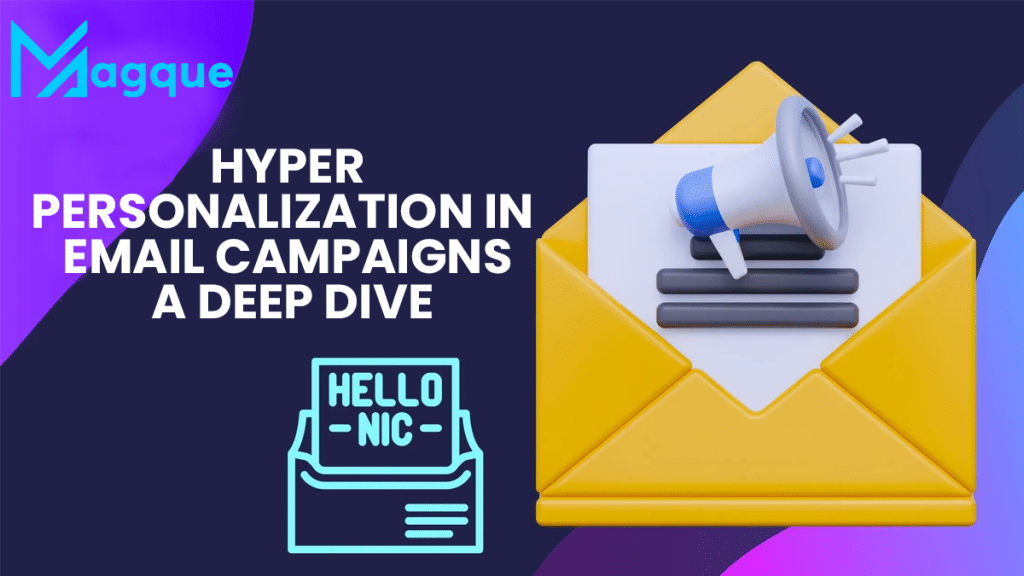Hey there! Have you ever wondered why some emails make you feel like they’ve read your mind? Well, that’s hyper-personalization for you, and it’s revolutionizing email campaigns as we speak. Let’s dive into this fascinating world and uncover how it can skyrocket your engagement and conversion rates, shall we?
First off, hyper-personalization isn’t just about slapping a first name in an email. Oh no, it’s about crafting an email experience so tailored and spot-on that your subscribers can’t help but feel it was made just for them. Imagine receiving an email that not only knows your name but also your preferences, your purchase history, and even your browsing habits. Mind-blowing, right?
So, how does one achieve this level of personalization? It all starts with data and lots of it. Collecting and analyzing customer data is the cornerstone of hyper-personalization. This could be anything from what pages they visited on your website, how they interact with your emails, to what products they linger on. The more you know, the more personalized your emails can be.
But here’s the kicker: with great power comes great responsibility. Privacy concerns are real, and navigating these waters is crucial. Always ensure your data collection methods are transparent and that your subscribers have opted in. Trust is everything in the email world.
You might be thinking, “This sounds great, but isn’t it a bit…creepy?” It’s all about balance. The key is to use this information to provide value, not to invade privacy. Think of recommendations that make sense, timely offers, and genuinely interesting content. It’s like having a friend who knows you well enough to give you precisely what you need when you need it.
But why go through all this trouble? Because it works. Hyper-personalized emails see higher open rates, better engagement, and increased conversions. They make your subscribers feel seen and understood, which, in turn, fosters loyalty and drives sales. In a world where inboxes are flooded daily, standing out is the name of the game.
Implementing hyper-personalization might seem daunting, but the payoff is immense. Start small, test, learn, and iterate. Remember, even the slightest personal touch can make a big difference.
So, there you have it. Hyper-personalization in email campaigns is not just a trend; it’s the future. And with the right approach, it can transform your email marketing into a powerful tool that connects, converts, and delights like never before. Ready to take your email campaigns to the next level? Dive into hyper-personalization and watch your engagement soar. Happy emailing!
There you go, a deep dive into the magic of hyper-personalization in email campaigns. It is tailored for you by Magque, who believes in the power of connection through personalization. Let’s make those emails not just another drop in the ocean but a beacon that lights up your customer’s day.
FAQs
Q1. What is hyper-personalization in email campaigns?
Hyper-personalization in email campaigns refers to the advanced strategy of using detailed customer data (like browsing behaviour, purchase history, and personal preferences) to create highly individualized email content. Unlike basic personalization, which might include using the recipient’s name, hyper-personalization aims to deliver content that resonates deeper, making each email feel uniquely tailored to the individual.
Q2. How does hyper-personalization differ from standard personalization?
While standard personalization might involve simple tactics like inserting a recipient’s name into an email, hyper-personalization goes further. It leverages big data, artificial intelligence, and real-time data insights to craft emails catering to each recipient’s interests, needs, and behaviours. This means more relevant product recommendations, content, and offers based on the recipient’s unique interactions and preferences.
Q3. What kind of data is used in hyper-personalized email campaigns?
Hyper-personalized email campaigns use a variety of data points to tailor content, including but not limited to browsing history, purchase records, email engagement metrics (like open and click-through rates), location data, and even social media interactions. The goal is to compile a comprehensive understanding of each customer to inform the personalization strategy.
Q4. Are there privacy concerns with hyper-personalization?
Yes, privacy is a significant concern when it comes to hyper-personalization. Businesses must ensure they collect and use data ethically and transparently, adhering to data protection laws such as GDPR in Europe and other regional regulations. Obtaining explicit consent from users for data collection is crucial, and providing clear options for opting out of data tracking and personalization is crucial.
Q5. How can I get started with hyper-personalization in my email campaigns?
Getting started with hyper-personalization involves several key steps:
- Data Collection: Implement tools and processes to collect and organize customer data across various touchpoints.
- Segmentation: Use the data to segment your audience based on behaviours, preferences, and demographics.
- Content Customization: Develop dynamic content that can be adapted based on your data for each segment or individual.
- Technology Integration: Utilize email marketing platforms that support advanced personalization features and can process real-time data for personalized content delivery.
- Testing and Optimization: Continuously test different aspects of your personalized emails (like subject lines, content, and timing) and use the insights to refine your approach.
Read Also This:- AI in Marketing Automating Personalization for Users
